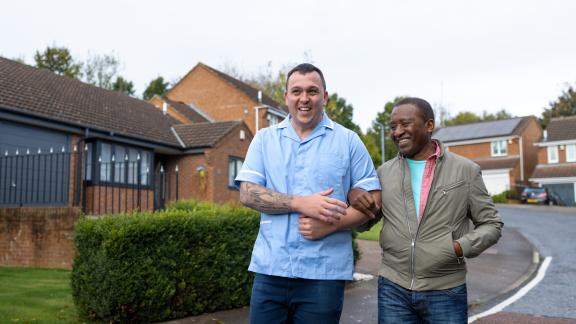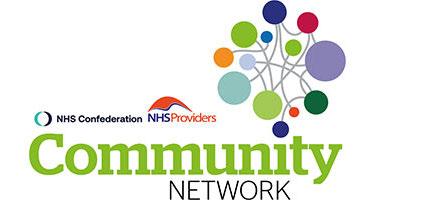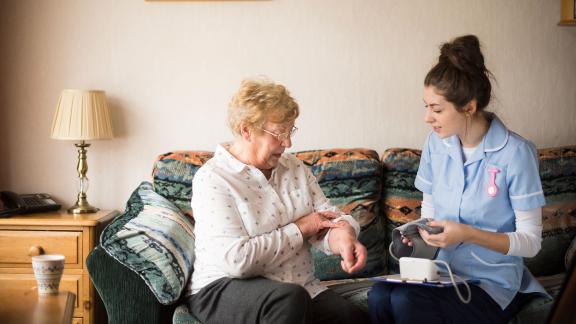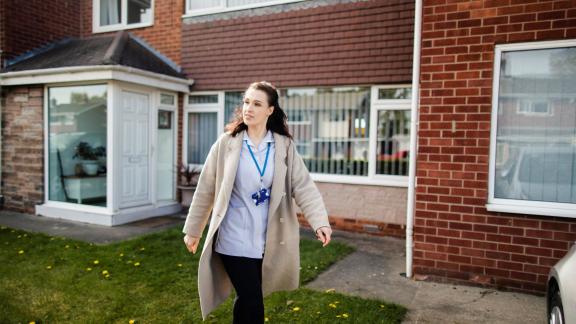Has the time finally come for community health services?

We find ourselves at a pivotal point with the upcoming release of the ten-year health plan. Grappling with longstanding operational and financial challenges, the NHS may be on the cusp of a wholesale transformation. Community services, working closely with partners in general practice, social care and the voluntary sector, are central to achieving the pledged ‘three shifts’ – not just from ‘hospital to community’, but ‘analogue to digital’ and ‘treatment to prevention’ too.
Each day, community health services carry out roughly 200,000 patient contacts, representing around 13 per cent of all daily activity across the NHS in England, providing essential support for people of all ages, including managing many long-term conditions. Areas that invest in community services reap the benefits of lower hospital activity, including emergency care. This demonstrates the very real opportunity to achieve better patient outcomes, join-up care and reduce the strain on other parts of the NHS.
The challenge ahead
But realising the longstanding ambitions of delivering care closer to home will be challenging. Lord Darzi laid it bare in his independent review: an NHS focused on late-stage, costly interventions through hospitals, despite the best efforts of successive governments. Even as staff struggle with growing burdens and take on ever-greater workloads, financial flows and old ways of working reinforce the status quo and increase pressure on acute hospital emergency care services.
This is unsustainable.
By 2039, over-75s will make up a tenth of the UK population, up from 7 per cent today. Combine this with increasingly complex mental and physical needs and rising numbers of people living with long-term conditions, and the need for change becomes clear.
Tight budgets – unlike the large, real-terms growth in spending seen during the 2000s – add further difficulties. With public trust in the NHS dropping, achieving better outcomes for patients, even as we wrestle with the system’s other challenges, could not be more important.
Yet providing care in people’s homes and communities is not just about providing better patient experience and outcomes – it makes financial sense too. Analysis by CF for the NHS Confederation demonstrated that for every £1 invested in the community or primary care, there is up to a £14 return back to the economy.
“So much of the way our current system works pushes patients towards the acute hospitals in a way that causes real difficulties for colleagues working in acute care,” says Richard Kirby, chief executive of Birmingham Community Healthcare NHS Foundation Trust and the new chair of the NHS Confederation and NHS Providers’ Community Network.
“We've got to work differently with acute colleagues as well as colleagues in primary and community and social care to change this. But we've not historically come together in the primary and community care sector with the structure, intent and purpose that would really help us rise to this challenge,” he admits.
Increasing the size, scale and focus on community-based services can be the key to unlocking these challenges, starting with the ten-year health plan.
The future is already here: where community leaders are already leading
Fortunately, there are a wealth of enterprising leaders in the community sector who are seizing the opportunity to manage what is in their control, make positive changes for their communities and bring the government’s shifts to life.
Richard’s trust has worked closely with colleagues, including from primary care, mental health, social care and acute services, to create locality hubs which provide integrated, community-based care delivered by multidisciplinary teams. Built around defined ‘localities’, these bring care closer to those in need.
As he told the Health on the Line podcast: “We've just done it by being ultra-pragmatic…We're trusting the folk on the ground to make the best judgements they can within the framework of our integrated care model.”
With the development of a model for a neighbourhood health service underway, successes such as this can provide a valuable example to inform future thinking.
Despite current plans to double the community workforce by 2037, the sector faces a high number of vacancies. Undeterred, providers are innovating.
At Wirral Community Health and Care NHS Foundation Trust, a programme of staff engagement – with a focus on learning and development – has contributed to falling turnover rates. Social enterprise Livewell Southwest has invested in ‘growing its own’ workforce by working closely with local communities, establishing new routes into employment and breaking down barriers to progression.
Hospital-at-home services, such as those run by Hertfordshire Community NHS Trust and Dartford and Gravesham NHS Trust, also demonstrate what moving services out of hospitals can achieve.
There, community teams, including district nursing and therapy services, are bringing care that was once only available within hospital walls to hundreds of patients a day in their own homes, through a mix of digital tools and face-to-face care. This means patients getting high-quality care without the disruption of travelling to hospital, which can, in turn, reduce pressure on overstretched acute capacity. This is one example of what the shift ‘from hospital to community’ could mean in practice, taken nationwide.
The service is fully integrated with the trusts’ integrated community teams, district nursing and therapy service, and has grown significantly over the last four years.
“We focus heavily on admission avoidance,” Hertfordshire’s chief executive and Community Network steering group member Elliot Howard-Jones, says.
“We focus heavily on a non-pathway model, so we look at the needs of the patient that is being referred to us and how we can keep them away from hospital and supported at home.”
Elsewhere, at any one time, Sussex Community NHS Trust has 110 people on virtual wards and 400 people being treated by urgent community response teams, each one getting treatment at or near home who might not otherwise have been. Likewise, Hertfordshire’s ‘-9’ initiative focuses on the nine days before someone is admitted to hospital, and how deterioration in the community can be identified and addressed before someone reaches crisis point.
Equally, the community sector is already showing the way ahead on how to reshape the flow of resources around the NHS – including investment in prevention.
Lincolnshire’s Community Alliance, created specifically to achieve a 50:50 balance between acute and community spending (compared to the previous 80:20 split), has enabled real change on the ground. As a result, the community sector and pharmacies are becoming the first point of contact for urgent health needs – with GPs consequently able to focus on long-term management of patients’ conditions. At the same time, specialist services too are leaving hospitals and entering community settings, boosting their accessibility and efficiency.
In short, community services are responding to the significant challenges affecting the whole of the NHS in innovative and collaborative ways. If the ten-year health plan is able to capture these examples (and countless others) from the community sector – and implement them at scale –the health service as we know it could change for the better.
Shaping tomorrow: four key priorities
Despite great examples of community providers providing excellent care across the country, there's scope to scale up and expand this work. That’s where the ten-year health plan comes in and why the Community Network is calling on it to focus on four key areas to empower community providers to deliver a sustainable NHS for the future.
1. Improve national data to support investment and prioritisation of the sector
In defining what community services need to cover, this year’s first-ever Standard Offer for the sector provided a welcome start in giving clarity to systems – which has the potential to improve interoperability and enable neighbourhood-level working.
But to move forward, community services need the tools to demonstrate how they add value to patients, and to the wider health and care system. For example, investing in timely and robust national data, taking into account the complexity and scale of providers across the sector, could tackle some of the challenges in building concrete business cases. As it stands, the National Community Services Dataset lacks the real-time data that could support quality improvement initiatives, identify gaps in service provision and link up with different partners, both within and without the health service.
For Matthew Winn, chief executive of Cambridgeshire Community Services and Norfolk Community Health, it’s an issue of access to ‘commonality of data’.
“I wince every time there is a fabulous report form the King’s Fund, the Nuffield Trust, and everyone else, saying ‘we don’t know enough about community health services’”, he reflects.
“I know in my own organisations, and in others’, there are copious amounts of data and insight into what we provide, but there’s no commonality and standardisation in what we do.
“We need to crack that, and we need to crack it rapidly…The providers of community health services need to be supported to become more digitally adept and data savvy in terms of how we’re providing information and analysis of what we do.”
2. Tackle system-wide pressures through community-led transformation
Secondly, it’s essential that the plan fully grasps just how community services could reduce pressures felt in other parts of the NHS. The recently published urgent and emergency care plan, in particular, shows how so many challenges facing the NHS require a system-wide response. Issues of patient flow through hospitals, high-intensity use of services and avoidable admissions all require solutions drawn from across the health system – including a central role for community services.
We therefore need to move as seamlessly as we can into the new ways of working set out since the start of the year. Big cuts to integrated care boards (ICBs), more duties for providers and the commitment to abolishing NHS England have forced every part of the health service to look again at how we operate. The community sector is uniquely placed to bring services and people together; the overhaul of the system’s architecture needs to empower community services to make a difference across every part of the NHS’s activities.
“I’m enthusiastic about the ambition of moving models of care,” says Richard Kirby.
“My sense is the bulk of the energy and activity around redesigning pathways will come from clinical colleagues within providers working in partnerships... The role for strategic commissioners is in setting the scale and ambition of the task and bringing providers together to ensure effective partnerships but the bulk of pathways redesign needs to sit with the clinical staff working with communities.”
That means setting out a clear role for the community sector within neighbourhood working, for instance. Alignment between the planning guidance, standard offer, the ten-year health plan, and the urgent and emergency care plan offers some welcome consistency which should continue. The upheaval that moving to neighbourhood working will bring – essential but a challenge to implement nonetheless – means that all partners, community services included, require clear roles and responsibilities with any new ways of working.
3. Prioritise the recovery of children and young people’s community services
Lord Darzi was right when he said that “childhood is precious because it is brief; too many children are spending too much of it waiting for care”. Indeed, even as the NHS seeks to get back to the 18-week referral-to-treatment target for elective procedures, the waiting list for children and young people within the community sector has only continued to grow – totalling over 314,000 as of May 2025 versus around 280,000 12 months previously.
Waits for care at a young age can be especially devastating, adding the risk of developmental delays alongside morbidity and mortality. However, waits in children and young people’s community services receive comparatively little national attention. Whether it’s long waits for audiology, speech and language, or neurodevelopment assessments (such as autism or ADHD), children and young people – and their families – are feeling the impact.
Elliot Howard-Jones is proud of the inroads his trust has made on reducing waits for neurodiversity assessments among children and young people. Nonetheless, there is action nationally needed to support local leaders to go further.
“It is very difficult when you are on a waiting list for a neurodiversity assessment and your peer group moves away from you when you're in school,” he says.
“That's really difficult ground to catch up on. Indeed, many people with neurodiversity do not catch that up. So we need to reduce those waiting times.”
4. Ensure funding follows ambitions for the left shift
Lastly, the ten-year health plan needs to be the catalyst for finally making the left shift happen. Despite the ambitions of previous governments of all political colours since 2006, community services’ proportion of NHS funding has shrunk – even as acute settings have seen their share of the overall budget grow from 47 per cent to 58 per cent.
Rebalancing NHS funding, therefore, is essential. This means moving resources away from reactive care and toward more preventative services that can slow the progression of illness – or halt it altogether. To achieve this, reformed financial flows – and the metrics which underpin them – need to incentivise shifting resources towards prevention, early intervention and care delivered closer to home.
For Siobhan Melia, chief executive of Sussex Community NHS Foundation Trust, outcomes-based commissioning “would incentivise all parts of the healthcare system, so everyone has skin in the game”.
Taken together, if reflected in the ten-year plan, these priorities could transform how we understand and harness the power of community services within the NHS.
Overcoming the barriers at scale
Unlocking the full potential of community services, however, can’t happen on the scale we need it overnight. The examples above show how ingenuity and strong leadership can achieve change despite some of the structural issues of today. To build a new model of care, and overcome the serious challenges the NHS faces, national policymakers need to enable community services to grow and drive transformation at pace.
For Richard Kirby, it starts with being clear that there is a national expectation that people take integrated models of care – the neighbourhood team – seriously.
“So it's not a ‘if you want to’, it's a ‘this is part of the standard national offer across primary and community services’.
“Secondly, it's about local freedom to let people work out how to do that in a way that reflects their population, their history, their structures.
“And, thirdly, it's ensuring that systems and organisations are accountable for the impact they have. In a way, we are used to being accountable for the big national access targets and those other things that we know are top of the list in terms of delivery.”
On the eve of a new ten-year plan for the health service, the time has come for community services to achieve their full potential.
“If effectively empowered, the sector can drive the ‘three big shifts’ forward, moving the NHS to the neighbourhood working that will transform how we provide care in the years to come,” says Richard Kirby.
“Faced with an ageing population and an unremitting financial squeeze, change is no longer optional – it's essential.”

The Community Network is the national voice of NHS community providers.
Hosted by the NHS Confederation and NHS Providers, we support trusts and not-for-profit organisations providing NHS community health services to deliver high-quality care by influencing national policy, sharing good practice and promoting a vision of integrated care in the community.



